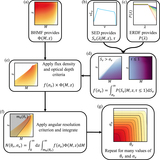Toward Determining the Number of Observable Supermassive Black Hole Shadows
Abstract
We present estimates for the number of shadow-resolved supermassive black hole (SMBH) systems that can be detected using radio interferometers, as a function of angular resolution, flux density sensitivity, and observing frequency. Accounting for the distribution of SMBHs across mass, redshift, and accretion rate, we use a new semianalytic spectral energy distribution model to derive the number of SMBHs with detectable and optically thin horizon-scale emission. We demonstrate that (sub)millimeter interferometric observations with ~0.1 μas resolution and ~1 μJy sensitivity could access >106 SMBH shadows. We then further decompose the shadow source counts into the number of black holes for which we could expect to observe the first- and second-order lensed photon rings. Accessing the bulk population of first-order photon rings requires ≲2 μas resolution and ≲0.5 mJy sensitivity, whereas doing the same for second-order photon rings requires ≲0.1 μas resolution and ≲5 μJy sensitivity. Our model predicts that with modest improvements to sensitivity, as many as ~5 additional horizon-resolved sources should become accessible to the current Event Horizon Telescope (EHT), whereas a next-generation EHT observing at 345 GHz should have access to ~3 times as many sources. More generally, our results can help guide enhancements of current arrays and specifications for future interferometric experiments that aim to spatially resolve a large population of SMBH shadows or higher-order photon rings.
- Publication:
-
The Astrophysical Journal
- Pub Date:
- December 2021
- DOI:
- 10.3847/1538-4357/ac2eb5
- arXiv:
- arXiv:2108.05228
- Bibcode:
- 2021ApJ...923..260P
- Keywords:
-
- 162;
- 479;
- 1663;
- 1769;
- Astrophysics - High Energy Astrophysical Phenomena;
- Astrophysics - Cosmology and Nongalactic Astrophysics
- E-Print:
- 37 pages, 18 figures, published in ApJ
